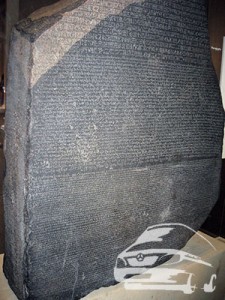Six Remarkable Ancient Artifacts Which You Can See in the British Museum
Posted by Jerrard Romanoff in Guides, on March 11, 2015The British Museum is one of the world’s most famous and visited museums. The museum is also the home of some of the world’s most important ancient artifacts. Here are six some of the most iconic exhibits that are displayed in the numerous galleries of the British Museum.
 The Rosetta Stone – This ancient relic dates back to 196 B.C and was found in el-Rashid, Egypt in 1799 by French soldiers who served under Napoleon Bonaparte. The stone was been in British possession since 1802 and has an engraving in three different scripts (Greek, demotic Egyptian and hieroglyphs). The discovery of the stone allows scholars and linguists to read hieroglyphics for the first time.
The Rosetta Stone – This ancient relic dates back to 196 B.C and was found in el-Rashid, Egypt in 1799 by French soldiers who served under Napoleon Bonaparte. The stone was been in British possession since 1802 and has an engraving in three different scripts (Greek, demotic Egyptian and hieroglyphs). The discovery of the stone allows scholars and linguists to read hieroglyphics for the first time.- Elgin Marbles – The Elgin Marbles are a collection of carved friezes and statues which once ornamented the world famous Parthenon in Athens, Greece. The relics came into British hands in 1816 after they were purchased from a Thomas Bruce. The 7th Earl of Elgin, who during a decade removed a total of 19 statues and 56 friezes from the most symbolic of the Greek capital.
- The Sutton Hoo Ship Burial Helmet – This artifact is an Anglo-Saxon warrior’s helmet which was discovered by Basil Brown during the late 1930s. The helmet was found inside a ship burial at Sutton Hood in the county of Suffolk. An astonishing fact about the helmet is that Brown found it in pieces, 500 to be more precise. After all pierces were gather it was put together by restorers on two occasions (1947 and 1968).
- Colossal granite head of Amenhotep III – This gigantic head is approximately nine and half feet tall and weight exactly four tonnes. The head depicts Egyptian pharaoh Amenhotep III who rules Ancient Egypt from 1390 to 1325 B.C. The head was discovered during the second decade of the 19th century and was purchase by the British Museum in 1823.
- HoaHakananai`a (The Easter Island Statue) – This colossal statue was carved around 1200 A.D on the Eastern Island in the Pacific Ocean. The statue was acquired by Commodore Richard Ashmore Powell in 1869. It was given to Queen Victoria by the Lords of Admiralty, who in her turn donated the statue to the British Museum.
- Aztec Double-Headed Serpent – This snake figuring is made out of wood and is one of the best preserved pieces of Mexica (Aztec Art) in the world. The figurine is covered with turquoise mosaics and adorned with conch and oyster shells. Historians believe that the Aztec Double-Headed Serpent was created somewhere between the 15th and 16th century. The figurine was been of the museum’s collection since 1894.
As you can see the British Museums showcases some of the world’s most amazing treasures. So as soon as your relocation is successfully completed with the aid of professional movers visit the museum and see these relics with your own eyes. Don’t hesitate to use moving services for your move because by doing so you will drastically facilitate the entire project from the packing to the loading to the transporting.
Other renowned artifacts of the museum are the Vindolanda Tablets, the Cat Mummies, the Portland Vase and many, many more.

 The Rosetta Stone – This ancient relic dates back to 196 B.C and was found in el-Rashid, Egypt in 1799 by French soldiers who served under Napoleon Bonaparte. The stone was been in British possession since 1802 and has an engraving in three different scripts (Greek, demotic Egyptian and hieroglyphs). The discovery of the stone allows scholars and linguists to read hieroglyphics for the first time.
The Rosetta Stone – This ancient relic dates back to 196 B.C and was found in el-Rashid, Egypt in 1799 by French soldiers who served under Napoleon Bonaparte. The stone was been in British possession since 1802 and has an engraving in three different scripts (Greek, demotic Egyptian and hieroglyphs). The discovery of the stone allows scholars and linguists to read hieroglyphics for the first time.